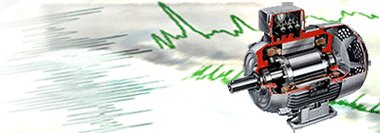
การวิเคราะห์และตรวจสอบมอเตอร์ไฟฟ้า

| HOME | OVERVIEW | PRODUCT | INDUSTRIES SERVICES | TRAINING MCA | CONTACT US |
 More facts about winding faults:
|
 Technology Overview Technology OverviewAbout Winding Faults There are four basic types of winding faults.
|
| Only about 17% of electrical faults begin as a conductor to ground fault. The other three fault types may or may not propagate into a ground fault as the failure becomes advanced. The short-term result of these faults is reduced efficiency (and higher operating costs). Symptoms include higher operating temperatures, perhaps nuisance tripping, and reduced motor life. As faults advance, the ability of the motor to drive the load may decrease. The longer-term result is always motor failure. | |
MCA & ESA System Evaluation  Green indicates that a developing fault can be both detected and trended for Condition Based Monitoring or Predictive Maintenance purposes. Yellow indicates a fault can be detected, but is difficult to trend or cannot be detected at an early state. | |
| Off-Line testing using Motor Circuit Analysis Motor Circuit Analysis (MCA) is a de-energized test method and the test can be initiated from the Motor Control Center (MCC) or directly at the motor. The advantage to testing from the MCC is the entire motor system, including the connections and cables between the test point and the motor, is evaluated. ALL-TEST PRO MCA instruments apply a low voltage, non-destructive AC signal through the motor windings and measure the response to these signals. Winding faults are indicated by variances in the response to the applied signal through the windings. These variances cause unbalances in the measured response to the applied signal. Therefore, when testing 3-phase equipment such as motors, generators, or transformers the response of each phase is compared to the other two. When testing single phase devices or DC motors then the winding is compared to itself or compared to a like single phase device or a like DC motor. ALL-TEST PRO MCA test instruments measure the phase angle (Fi), the current/frequency response (I/F), the impedance (Z) and depending upon the instrument, the resistance (R) and the inductance (L) of each winding. The unbalances of these measurements are compared and simple rules are used to determine the condition of the device under test. Moreover, each instrument will perform an insulation to ground test. Computer software can be used to analyze the condition of the device under test and provide the user with a written report. Results can also be trended for identifying long term motor faults. I.e. used for Condition Based Maintenance or Predictive Maintenance purposes. For evaluation of the windings, whether a fault is developing between turns in a single coil, coils in the same phase, or coils across phases, the unbalance(s) between phases for the phase angle (Fi) and current/frequency response (I/F) measurements are evaluated. The insulation to ground test is used to evaluate for conductor to ground issues. Phase resistance is evaluated looking for connection issues, inductance is evaluated for possible rotor problems, and impedance and inductance matching are used to detect contamination or over-heating of the windings. The off-line test takes only a few minutes and if testing from the MCC, the connections, cables and the motor are evaluated. | |
| On-Line Testing using Electrical Signature Analysis Electrical Signature Analysis (ESA) is an energized test method where voltage and current waveforms are captured while the motor system is running and then, via a Fast Fourier Transform (FFT), a spectral analysis is done by the provided software. From this FFT, faults related to incoming power, the control circuit, the motor itself, and the driven load are detected and can then be trended for Condition Based Maintenance/Predictive Maintenance purposes. All ESA analysis systems require motor nameplate information of voltage, running speed, full load current, and horsepower (or kW). Additionally, optional information such as rotor bar and stator slot count, bearing numbers, and information for driven load components, such as blade count for a pump or tooth count for a gear box application can be entered for a more detailed and accurate analysis. Energized on-line testing will provide valuable information for AC induction and DC motors, generators, wound rotor motors, synchronous motors, machine tool motors, etc. ALL-TEST PRO ESA instrument is actually two instruments in one- a complete Power Quality Analyzer (PQ) and complete Motor Analyzer (ESA). When in PQ mode it can be used for energy data logging, harmonic analysis, voltage and current charting, view waveforms, waveform capture of sags and swells, transient capture, and event capture. When in ESA mode, it will provide the analyst with information about incoming power, mechanical and electrical health of the stator, rotor analysis, air gap analysis, and analysis of the driven load (gear boxes, belted applications, bearing, etc). |
|
©Copyright 2012 - Thermoscan Co., Ltd. - All Rights Reserved.
Thermoscan Co., Ltd. (บริษัท เทอร์โมสแกน จำกัด)
731 PM Tower, 5th Floor, Asok Dindaeng Road, Dindaeng, Dindaeng, Bangkok 10400
Tel: (02) 642-9489 Fax: (02) 642-9424
E-mail: tms@thermoscan.co.th